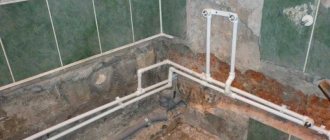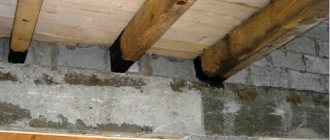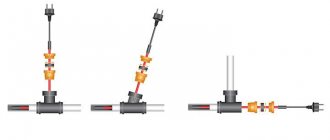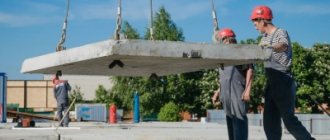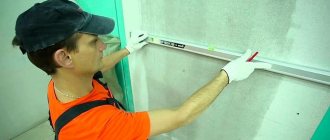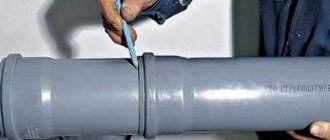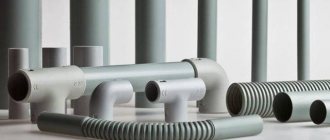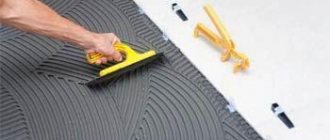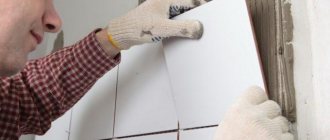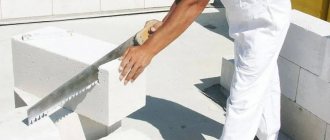Installation of sleeves in walls and ceilings for utility networks
| Page 1 of 2 | 1 | 2 | > |
18.05.2016, 10:09
| 17.05.2016, 19:05 | #1 |
| #2 |
18.05.2016, 10:17
This joint venture is not mandatory in accordance with Resolution 1521 and is advisory in nature and, as a result, I want to do it, I don’t want to, I don’t do it.
I need a document indicating the need for sleeves without any reservations. Just bet and that's it. For a long time I searched and didn’t find anything on my own; the last similar topics on the forums were raised in 2013. I decided to refresh the question; suddenly, with the new regulatory framework, new points appeared that eliminated this vagueness of the issue. This will allow the Customer not to fuss and save on installing these sleeves for all utility risers, and not just heating and hot water systems.
18.05.2016, 10:31
18.05.2016, 11:31
This is precisely the question of sufficiency, it is not written down anywhere, but there is an opinion that it is necessary to install it, because when pouring concrete, it is easier to immediately lay this sleeve in place of the embed and use it as formwork. There is also an opinion that with the installation of a steel sleeve it is easier to fill the space between the riser and the sleeve with non-flammable, elastic material, followed by cementation, and as a result, further repair of this area with its replacement. But this: 1. Hemorrhoids, if the sleeves were not placed immediately when pouring the floors (for fear of placing them out of alignment, it is easier to lay a rectangle, and then let the plumbers catch their own axles and cement the excess), they need to be cut, pinched, etc. Installation time will increase and, as a result, payments to plumbers will increase. 2. I remember the Soviet echo and the desire to lay glassine - which is very flammable.
The issue of installing sleeves in sewer risers, for example, disappears if there are no holes for the risers and diamond cutting is used to bluntly cut holes of the required diameter for their installation, but then the question is, what do the designers who issue the documentation take money for, they know where the networks will go, what diameter, and you can immediately lay openings in the sections of the housing in order to reduce the work of drilling holes and the costs for them.
18.05.2016, 11:50
You can fill the hole in the formwork not with a steel sleeve, but with a PVC pipe - then remove it. It's cheap - no problem.
18.05.2016, 11:59
18.05.2016, 13:53
Technical catalog VALTEC - reference book Vesta Trading 2013 Fifth edition
Excerpts from regulatory documents (continued)
PASSAGE THROUGH STRUCTURES
Where they pass through building structures, pipes made of polymer materials must be laid in sleeves. The length of the sleeve must exceed the thickness of the building structure by the thickness of the building finishing materials, and rise above the floor surface by 20 mm. The placement of pipe joints in sleeves is not allowed. 3.6.1. SP 40-102-2000 For passage through building structures, it is necessary to provide cases made of plastic pipes. The inner diameter of the case should be 5-10 mm larger than the outer diameter of the pipe being laid. The gap between the pipe and the case must be sealed with a soft, waterproof material that allows the pipe to move along the longitudinal axis. 3.10 SP 40-103-98 Pipelines at the intersections of ceilings, internal walls and partitions should be laid in sleeves. The edges of the sleeves should be flush with the surfaces of walls, partitions and ceilings, but 30 mm above the surface of the finished floor. Gaps and holes where pipelines pass through the structure of the house should be sealed with sealant. 7.2.5.4 SP 31-106-2002 For the passage of pipes through building structures, it is necessary to provide sleeves. The inner diameter of the sleeve should be 5-10 mm larger than the outer diameter of the pipe being laid. The gap between the pipe and the sleeve must be sealed with a soft, fireproof material that allows the pipe to move along the longitudinal axis. 5.7 SP 41-102-98
18.05.2016, 15:22
Technical catalog VALTEC - reference book Vesta Trading 2013 Fifth edition
Excerpts from regulatory documents (continued)
PASSAGE THROUGH STRUCTURES
3.6.1. SP 40-102-2000 3.10 SP 40-103-98 7.2.5.4 SP 31-106-2002 5.7 SP 41-102-98
According to Valtek, they took this from SP 30 for non-standard conditions, for example, seismic areas, as they say for sure (I myself am not against it). According to all the data from SP, unfortunately, they were not included in Resolution 1521 and, as a result, are not mandatory, but is only a recommendation; the Customer has the right to refuse these recommendations. You need something significant, which is enshrined either in accordance with 1521 or in accordance with some resolution of the Russian Federation.
For example, you laid the shell casings, I say remove them, they cost money, what are your actions? Please refer to these documents. I say they are not obligatory, we will not implement them. What's next? Are you removing the cartridges?
Cost in the estimate for the installation of steel liners for tunnels and subways
One of the main types of work that requires the use of prices in the estimate for the installation of sleeves in walls and other structures is the construction of tunnels and subways of various types. For this type of structure, a collection of the same name 29 is presented in the databases of estimate standards GESN and FER.
As part of this collection, there is a table FER29-01-253, in which you can select prices in the estimate for the installation of sleeves. Table FER29-01-253 contains three standards that take into account this type of work.
The difference between the prices for the installation of the sleeve in the estimate, if they are used from table FER29-01-253, lies in the diameter of the sleeves. Thus, the standard coded FER29-01-253-01 takes into account the installation of steel sleeves with a diameter of 100 mm. The specified norm is given for demonstration in Figure 1.
Figure 1. Standard FER29-01-253-01
The second standard in the table FER29-01-253 is used as a price in the estimate for the installation of steel sleeves with a diameter of 150 mm, and the standard FER29-01-253-03 takes into account the installation of structures of this type with a diameter of 200 mm. All standards take into account the volume of work measured in quantities of 10 pieces. designs.
In addition, it should be noted that the work of all three prices in the estimate for liners from table FER29-01-253 includes only the installation of liners for concreting tunnel and subway structures. Therefore, if there is a need to take into account other types of work, for example, punching holes, in estimates according to Form No. 4, local resource calculations or in local estimates, they should be included as a separate item.
By the way, it is also necessary to note the fact that the prices in the estimate for the installation of sleeves used from table FER29-01-253 do not take into account the cost and consumption of steel pipes. The fact is that the type and range of pipes must be separately designated for each specific facility as part of the design documentation.
In this regard, in the prices for the installation of steel sleeves in the estimate, the brand and type of pipes must be included according to the actual data of the project. Based on this data, the cost of the material is indicated as part of the estimate form.
Installation of sleeves for passing pipes through ceilings
Installing a sleeve for pipe passage through ceilings should be done in certain cases, for example, when the pipeline is subject to thermal expansion. And the need to install the sleeve must be taken into account at the highway planning stage. All nuances of use should be taken into account not only when laying a new pipeline, but also when replacing old communications.
The area where the pipeline is laid through the walls and ceiling becomes the main point of deformation stress. In such places, the pipe is exposed to the chemical environment and mechanical loads. Due to such circumstances, in the SNIP building codes, pipelines are equipped with additional structural parts, which are called sleeves. What they are and why they need to be installed will be discussed in detail below.
The device for passing the pipe through the wall is an important element, and it performs the following functions:
- mechanical;
- protective;
- waterproofing;
- fire protection;
- sanitary.
In addition, this element can increase the service life of the highway and facilitate the replacement of structures.
The sleeve is arranged as follows:
- a case for which a steel structure is used;
- packings made of soft, fire-resistant material.
The sleeve for the passage of the pipe is made in the form of tubular products. And the free space between the structures is filled with fire-resistant material. It must not be rigid in structure. This is necessary so that when the pipe heats up, it will begin to change its dimensions, and if there is hard material, it may become damaged.
The diagrams provided above show that the highway can pass through any building in two planes. Thus, the ceilings between floors are crossed by vertical networks (risers), and the walls are crossed by wiring running horizontally. The provided figure shows an example of the arrangement of a part, first in the ceiling, and then in the wall.
In both the first and second cases, the cover of the part must be firmly secured. The tubular product must move freely through it. The diameter of the cover in one and in the second case must be 10 mm larger than the diameter of the pipeline. And the cover itself is securely fastened in the passage hole.
Installation and caulking of the main line cartridge is carried out by calculating the height that the screed has. The length of the sleeve should be 20 mm greater than the thickness of the ceiling. If this point is not observed, then there is a risk of water entering the floors located below.
Sleeve for passing pipes through the wall
- Articles
- Articles about Construction
- Sleeve for passing pipes through the wall
For internal walls and ceilings, a number of civil and industrial buildings, in most cases the following is necessary: • expansion couplings for passage through the wall - to level out the temperature expansion of the pipelines themselves; • fire protection couplings - to provide protection against flame penetration into adjacent rooms during a fire.
All these requirements are provided by the sleeve and couplings for the passage of pipes through the walls.
Features of the passage of pipelines through building structures
An incorrectly installed pipeline creates a potential danger of an emergency. Inside the building structure there are a large number of different utility networks. Communications of different materials and strength can pass through the same building elements. The technology for running a pipeline through building structures depends on their type and the material of its components. The latter can be made of copper, steel or various plastics.
How to ensure maximum service life of building structures and pipelines?
There are a number of recommendations: • According to SNiP standards, non-insulated units should not have direct contact with building structures; • Before the horizontal outlet, protection is provided with a cement layer of several centimeters; • Use sleeves (cases) in places where pipelines cross; • To increase sound insulation properties, an elastic material is used, which is placed in the gap between the outer diameter of the pipe and the inner diameter of the case; • Sleeve waterproofing can only be used for slabs; • During installation, uneven shrinkage of the foundation is taken into account: gaps are sealed with mastic or sealants. Moreover, the internal diameter of the case must exceed the diameter of the pipe by 2 cm; • Copper components are also placed in cases, and the border with the building structure is treated with cement, in wooden houses - with asbestos; • Changes due to temperature changes are compensated by means of sliding supports, which must be taken into account during the creation of the project
At the exit, install a fitting (tee, elbow) to prevent it from being removed from the wall
• Changes due to temperature changes are compensated by means of sliding supports, which must be taken into account during the creation of the project. At the exit, install a fitting (tee, elbow) to prevent it from being removed from the wall.
Laying pipes through ceilings
There are 2 main caveats: • When using flammable insulation, the space around the pipe must be treated with basalt fiber, which does not burn. • The minimum distance to wooden structures must be more than 13 cm. To create a unit, an opening is made in the ceiling, the lower part is strengthened and a pipe is passed through it
It is important that the joints of the components are not in the ceiling-passage assembly. A sleeve with a protrusion thickness is inserted (SNiP 2.04.01)
• Cement mortar is used to treat the area 10 cm above the ceiling, the layer should be a couple of centimeters 2-3 cm. • Pipes should be wrapped in waterproofing material, excluding gaps, and only then plastered. • Thermal elongation of pipes must be taken into account. • When the pipe passes through the ceilings, its free movement is ensured, i.e. install the sleeves. Moreover, their internal caliber should be 5-10 mm larger than the size of the pipe.
The space is sealed with soft material with non-flammable properties, which will allow the pipe to move freely. The protective case can be made of plastic or metal.
There are also additional requirements depending on the type of pipeline and purpose of the room, installation method.
Sleeves are used for the following reasons: • Straight sections of a polymer pipeline are susceptible to temperature changes, which requires free movement during thermal deformation. • For the possibility of dismantling if a section of the pipeline is damaged.
However, in some cases, the use of sleeves in building structures is not economically justified. In addition, sealing the space prevents the occurrence of unpleasant odors and insects. When using the sleeve in wet rooms, the seal must ensure tightness: water should not enter through the gap into the adjacent room.
Is it necessary to install liners?
The need to install a sleeve for the passage of pipes passing through walls is dictated by the requirements of SNIP. They are due to the following reasons.
- The polymer pipeline changes its dimensions due to the influence of temperature. In addition to expansion, it can move. To prevent deformation and create the necessary free space, SNIP recommends using sleeves. These devices for passing pipes through walls and ceilings make it possible to maintain the integrity of the structure during installation activities and during significant temperature changes.
- SNIP also states that a device for passing pipes through walls and ceilings allows dismantling without destroying the structure.
- Installing protection for the passage of pipes through walls, ceilings or foundations becomes a barrier to the penetration of odors and insects from adjacent rooms.
In accordance with SNIP, sleeves are recommended to be installed only in certain cases. Their installation is not always considered advisable. Also, waterproof material for laying between pipe products is recommended in situations where the cartridge is laid through a passage unit through the ceiling.
Let's look at what types of sleeves there are
Sleeves for the passage of pipes in accordance with the requirements of SNIP differ in the material of manufacture. In addition, the size of the device for passing the pipeline through a wall or partition also differs.
All of these indicators depend on the parameters of the structure being built. So, for example, the size of the inner diameter of the sleeve must be 20 mm larger than the size of the line thickness.
The size of the sleeve for passing the pipe through the ceiling also depends on the installation option of the building. The protrusion, which must necessarily pass in rooms where the water level indicator may be above a horizontal surface, is not necessary with hidden installation technology. But, in accordance with the requirements of SNIP, if installation is carried out using an open method, then the dimensions of the device must meet the characteristics of the premises.
The same SNIP rules state that the size of the interpipe space must be set to be suitable for the installation of fire-resistant or water-resistant material. In addition, it is important to note that the SNIP rules emphasize that the dimensions of devices for arranging passage through walls or floors should not create obstacles to the free passage of the main structure. This is a prerequisite for carrying out repair activities.
The inner diameter of the sleeve for running pipes in ceilings should not be five or ten millimeters larger than the outer diameter of the heating pipeline.
Features of use
For sleeves, sections of pipe products are used. Experts call steel or polymer the best option for this. The choice of material is influenced by the design of the building. So, for example, for reinforced concrete buildings it makes sense to install elements made of steel, which are not difficult to concrete both in the factory during the production of wall panels, and at construction sites when installing heating lines.
Installation of a steel sleeve into a hole without machining the end parts is not allowed. Thus, during installation it is possible to harm the polymer pipe product. If the cartridge is installed in a wall made of other materials, then their low adhesion to cement mortar should be taken into account.
It is not recommended to use construction roofing felt for the cartridge. In this case, a poor reaction of the polymer to oil-containing materials is noted.
In order to prevent the spread of fire, it is recommended to install special fire cutters at the intersection of the heating pipeline and walls and ceilings.
Features of pipe installation
The method of installing a pipe passage through a wall or ceiling in a sleeve depends on the type of communication being laid. And each type has its own characteristics. To ensure reliable protection for your structure, it is worth understanding these differences in more detail.
Water pipes
Watch video [sociallocker]
If the gasket of this system is made of steel products, then they must be protected in the area of the wall or ceiling connection with a coating that is resistant to moisture. If the line is intended for cold water, then you will need to install a special thermal cover. This will make it possible to avoid the appearance of condensation on the surface, and thus the system will last longer.
If polymer or combined pipe products are used, then when arranging a passage in the wall, you must familiarize yourself with the manufacturer’s recommendations, which are attached to the manufactured products.
If there is a risk of groundwater pressure in the area where the main line enters the home, then craftsmen recommend installing waterproofing cartridges in the hole, which prevent water from entering the basement.
Drain networks
The output unit for cast iron products differs from similar devices made from other materials. The thing is that cast iron does not require sound insulation or reinforcement.
A plastic drain network in the wall will require a steel cartridge. The length of the device should be 15 - 20 mm greater than the same characteristic of the pipe, and the length should be 2 - 3 cm greater than the width of the wall. The unit at the point of passage through the ceiling or wall is wrapped with waterproofing. And the passage area is sealed with cement mortar.
Steam heating
The sleeve for the passage of heating pipes is a mandatory element. This is due to deformation from the temperature effect on metal buildings and stress on straight sections of the highway with a significant temperature difference. These factors cause cracks in the structure and can also cause it to fail.
The installation and location features of the sleeve device in heating pipes are similar to those used for hot water supply systems. If they pass through the interior wall, then you can install a line that is not made of steel. In such cases, plastic or combined type options from different manufacturers are suitable.
The specificity of such systems is the presence of individual fasteners, which also include a sleeve for heating pipes. For most manufacturers, these elements are highly technologically advanced and create all the conditions for the desired pipeline slip rate, which leads to various increases and deformations of plastic from different manufacturers.
Chimney systems
The installation of liners when laying chimney pipes must be carried out in strict accordance with all construction requirements.
If the chimney is made of steel, then the outlet through the hole in the ceiling will require the installation of a hollow sleeve, for the production of which galvanized iron is used. In addition, the upper and lower parts are insulated with a plate that will protect from fire.
If flammable material is used during the installation of building structures for the chimney, then the external side of the hollow part must additionally be insulated with fire-resistant insulation.
Basalt fiber or asbestos is excellent for such an installation. From a fire safety point of view, installing a chimney hole in the roof will require special attention. And it is very important when installing a building with a chimney liner to comply with the required level of regulatory requirements.
Problems that the device must solve
When installed, any element of this line must effectively cope with the following tasks:
- providing reliable protection against erosion in the event of a rupture, or in cases where the main connections begin to leak, therefore, any emergency breakdown will not cause much damage to the building;
- in the area where the main line will pass, the cartridge must firmly protect the surface of the network from mechanical influence, environmental influences and deformation changes;
- the cartridge in the hole for conducting the system must reliably protect against sudden changes in temperature, which in itself has a destructive effect on the constructed line.
- the cartridge in the hole for laying the system should become a reliable protection for the structure if it is necessary to quickly carry out dismantling measures.
When purchasing these devices, you need to remember that you should contact a trusted manufacturer. Only in this case can you obtain a guarantee of the proper quality of the purchased product.
You need to understand that the money spent on the sleeve is not large, but the benefits from it are enormous. It not only facilitates repair work, but also helps to extend the service life of the pipeline, and therefore save large costs for repair work.
To ensure that the installed part is securely fixed and the pipe product does not move around in it, it is better to buy a product of standard GOST size for highways. The volume of the cartridge according to GOST must necessarily correspond to the volume of the pipe.
If you are not sure about the correctness of your choice, then it is better to ask specialists for help with installation. They will help you design a high-quality structure that will last for decades.
Traditional solutions
Typically, to seal the gap of the 1st passage of pipes, the following is used: - a heel (woven rope, rope, made of organic or synthetic material, impregnated with an oil-containing solution to improve the sealing properties of the fiber); — sealants; — construction foam; — cement mixtures; - combinations of materials (cabinet and cement mixture);
General disadvantages of using traditional materials for compaction and sealing (cabbage, foams and sealants, cement mixture): - fragility, over time they cake, lose their original volume and elasticity, every spring-autumn period, as a rule, there is a need for work to prevent leaks;
- cannot withstand pressure of more than 2 bar, are squeezed out of the hole, leak; - absorb moisture; - poorly compensate for vibration (water hammer) and other operational loads (temperature changes) on working pipes, which is why gaps and cracks appear in the seal through which moisture seeps in; - if leaks occur, they are beyond repair; cleaning of the interpipe space and their complete replacement are required.
The usual consequences for basements are leaks, containers placed under the ends of the sleeves to collect leaking water, rusty streaks on the walls, standing groundwater, high humidity, corrosion of pipes and metal structures, and in the worst cases, the appearance of fungus and mold. In a humid and warm room, conditions are created for the reproduction of insects, which, through the ventilation system and open doors, enter higher-lying apartments and offices. Thermal chambers are often filled to the groundwater level, even in modern residential complexes.
We suggest you familiarize yourself with Fastening insulation to the wall with dowels
Prolonged penetration of moisture into premises creates conditions for the formation of mold and mildew, which negatively affect health, as well as the structural elements and decoration of buildings, houses, and their internal contents (equipment, furniture, textiles, etc.). Fighting mold is quite expensive, not environmentally friendly, and often impossible.
The wisdom of installing liners for pipelines
Installation of pipelines in capital structures requires a serious approach already at the network planning stage. It is equally important to take into account all the nuances of the operation of communications when replacing old highways. The points where pipes pass through walls, floors and foundations are concentrators of deformation stress. In these areas, network elements are subject to mechanical and chemical influence, therefore, in accordance with building codes and regulations, they are supplied with additional structural elements - sleeves. What are sleeves for passing pipes through walls, SNiP restrictions in this direction, the nuances of the device - you will now receive all this information in full in order to understand this topic.
Important little things
The pipeline sleeve is an important element. And this applies to communications of various buildings - residential, office or industrial. The part performs a number of functions: mechanical, protective, waterproofing, fire protection, sanitary, and also increases the service life of pipelines and facilitates their replacement. The design of sleeves for the pipeline depends on its type.
Common types of pipelines for capital structures are as follows:
- cold and hot water supply;
- drainage system (internal sewerage);
- steam heating heat pipeline;
- stove chimney.
Elements passing through the building structures can be metal (usually steel, less often copper), plastic (polyvinyl chloride or polypropylene), or a combination (plastic encased in an aluminum alloy). For the installation of sleeves, the material of the products passing through interior walls and interfloor ceilings, as well as the material of building structures, is important. Typically the pipeline is steel, the walls are brick, and the ceilings are reinforced concrete.
Product design
The pipeline can cross building structures in two planes. Interfloor ceilings are crossed by vertical pipelines (risers), walls - by horizontal ones (wiring). The figure shows an example of the installation of a product in walls (a) and ceilings (b). Actually, the sleeve consists of a cover (1), for which a steel structure is most often used, packing (2), which can be a soft non-flammable material, but Portland cement is often used (which, according to experts, is undesirable). The cover is firmly fixed. The pipe (3) passes freely through the cover (the diameter of which should be 5-10 mm larger than the pipe) and is fixed in the wall (4) or ceiling (6). Installation and caulking of pipeline sleeves in floors is carried out taking into account the height of the screed (5) or other floor covering, and the length of the product should be at least 10, or even 20 mm, greater than the thickness of the floor. This is important to prevent emergency water masses from penetrating to the lower floors.
This is important to know! The section of pipe where it passes through the wall should not have seams.
Pipeline crossing of building structures: sleeves, seals, bushings
The article contains excerpts from various sources on how water supply and drainage pipelines cross building structures. The intersections of pipes with walls of pumping stations, water supply and sewer wells, walls and ceilings of buildings and structures are considered. Also considered are modern sealing methods, often used in the reconstruction of buildings and structures - sealed bushings and Link-sil.
Passage of pipelines through the walls of pumping stations
a) Rigid seal using a ribbed pipe b) Flexible seal using a pressure gland c) Flexible seal using a stuffed gland Figure from the manual by the authors E. V. ZALUTSKY, A. I. PETRUKHNO “Pumping stations”.
The pipe can cross building structures and be sealed rigidly or flexiblely, i.e. There are rigid and flexible seals. Flexible sealing is used in cases where damage to pipes is possible due to building settlement, thermal expansion, and in seismic areas.
a) Rigid seal using a ribbed pipe
The welded edge of this pipe ensures the strength of the seal and reduces possible filtration of groundwater along the working pipe. The working pipe is welded to the finned pipe, or flanges are welded to it. It is used when damage to the pipe due to building settlement or for other reasons (thermal expansion or seismicity) is impossible.
Finned pipes are produced according to the standard series 7.901-6.
b) Flexible sealing using a pressure gland
It is used in difficult conditions when the groundwater level is higher than the pipe passage through the wall. In addition, such an oil seal should be installed in the walls separating the dry and wet compartments in sewage pumping stations, placing a flanged pressure pipe (5) on the side of the wet compartment.
Packing seals are produced according to the standard series 5.900-3
c) Flexible sealing using a stuffing box
There is no flanged pressure fitting in the body of such an oil seal. A thrust ring and two collars are installed inside the housing. A packing of tarred hemp strands is placed between the thrust ring and the collar. The ends of the seal are caulked with asbestos-cement mass and sealed with bitumen mastic. Such seals are used in low-moisture soils. In dry soils, tow and rags can be used as padding.
Pressure seals are produced according to the standard series 5.900-2
Passage of pipelines through the walls of water wells
Schemes from TPR 901-09-11.84 Water wells
Scheme A) for dry soils
Scheme B) In the presence of groundwater
Scheme B) For subsidence soils. A waterproof castle is made of tightly packed crushed clay mixed with bituminous or tar materials.
Passage of pipelines through the walls of sewer wells
Schemes from TPR 902-09-22.84 Sewer wells:
Scheme A) for non-subsidence dry soils
Scheme B) for wet soils
Scheme B) for subsidence soils
Schemes for the intersection of external walls (foundation walls) of buildings from the standard series 5.905-26.08 “Sealing utility inlets of gasified buildings and structures”
Sealing water supply or sewerage inlets in dry soils
Sealing water supply or sewerage inlets in wet soils
Pipelines crossing building structures inside buildings
Based on materials from Album 2.029 KL-2 “Lenniiproekt”
Laying through walls on floors
Laying through the ceiling
Laying through walls in a technical underground
clause 4.1.10 SP 41-109-2005 (Design and installation of internal water supply and heating systems of buildings using cross-linked polyethylene )
For pipes to pass through building structures of walls and ceilings, it is necessary to provide sleeves. The inner diameter of the sleeve should be 5-10 mm larger than the outer diameter of the pipe being laid. The gap between the pipe and the sleeve must be sealed with a soft, fireproof material that allows longitudinal movement of the pipe. The sleeve should protrude 3-5 cm above the floor, and be flush in partitions and near the ceiling.
clause 3.6.1 SP 40-102-2000 (Design and installation of pipelines for water supply and sewerage systems made of polymer materials . General requirements)
Where they pass through building structures, pipes made of polymer materials must be laid in sleeves. The length of the sleeve must exceed the thickness of the building structure by the thickness of the building finishing materials, and rise above the floor surface by 20 mm. The placement of pipe joints in sleeves is not allowed.
clause 7.2.5.4 SP 31-106-2002 (Design and construction of engineering systems of single-apartment residential buildings)
Pipelines at intersections of ceilings, internal walls and partitions should be laid in sleeves. The edges of the sleeves should be flush with the surfaces of walls, partitions and ceilings, but 30 mm above the surface of the finished floor. Gaps and holes where pipelines pass through the structure of the house should be sealed with sealant.
Pipelines crossing building structures of structures during their reconstruction
Using Link-Seal Annular Seals
For the passage of pipes through building structures, it is possible to use Link-Seal type annular space seals. This seal is a chain of rubber elements connected by bolts. When installing on a pipe where it passes through the wall, tighten these bolts one by one. The result is a reliable sealed unit.
Installation diagram of Link-Seal in a wall
Details on the use of Link-Seal can be found in this manual.
Using sealed bushings
A seal similar in principle is the so-called hermetic bushing. It consists of two flanges with rubber between them. During installation, the sealed sleeve is placed on the pipe and occupies the gap between the pipe and the wall of the hole (sleeve/case). The flanges are bolted together, and when they are tightened, the rubber expands and seals the input.
Hermetic bushing in the wall. Illustration – germovtulki.ru
Germovtulka
Types of pipelines
The order in which networks pass through walls or ceilings largely depends on what kind of communications are being laid. Let's figure it out.
Water pipes
If this network is installed using steel products, the general recommendations outlined above should be used. In this case, the surface of the pipe in the area where the wall or ceiling intersects must be protected with a moisture-resistant coating. For cold water supply, it is also necessary to provide a thermal cover, which will prevent the formation of condensation on the surface of the line and will extend the service life. When using a polymer or combined pipe, you must follow the manufacturer's recommendations set out in the product annotations.
If there is groundwater pressure at the entry point of the pipeline into the house, then special waterproofing sleeves can be used to prevent water masses from entering the internal (basement) rooms.
Sewerage
Cast iron products do not require sound insulation and reinforcement, and also do not require the mandatory arrangement of sleeves, which, however, can complicate the process of repair work. Plastic requires a steel pipe sleeve; for example, a larger cross-section product made from roofing steel can be used. The diameter of the part should be 15-20 mm greater than that of the pipe, and the length should be 20-30 mm greater than the width of the wall. The structure at the point of passage through the ceiling is wrapped with waterproofing material, and the passage section itself is sealed with cement mortar.
Worth paying attention! Do not use roofing felt or other organic materials that have an adverse effect on the plastic as wrapping material.
Heat pipe for steam heating
The mandatory use of sleeves for steam heating networks is due to thermal deformations of the metal and stress on straight sections of pipes during sudden temperature changes, which can cause the formation of cracks in building structures and failure of the heating system. In fact, the design and position of the sleeve for passing through ceilings is identical to that for hot water supply systems. When passing through interior walls, not steel, but combined or plastic pipelines from various manufacturers can be used. Their specifications provide for individual fastening and connecting elements, including a sleeve for passing pipes through the wall. Often these parts are high-tech and provide the required level of pipe sliding, which is due to different parameters of expansion and deformation of plastic from different manufacturers.
Chimney
If the chimney is made of steel elements, then when passing through the ceilings it is necessary to use a hollow galvanized iron sleeve, while the upper and lower surfaces are additionally insulated with a fireproof plate. If building structures are made of flammable materials (for example, wood), then the outside of the hollow sleeve is additionally insulated with non-flammable insulation, for example, basalt fiber or asbestos. From a fire safety point of view, the arrangement of the chimney passage in the roof requires special attention.
Do not forget to follow building codes and regulations, and you are already familiar with the main subtleties and nuances of installing liners.
Sleeves for passing pipes through walls SNIP - Club of Masters
> Walls >
02.11.2019
Installation of pipelines in capital structures requires a serious approach already at the network planning stage. It is equally important to take into account all the nuances of the operation of communications when replacing old highways. The points where pipes pass through walls, floors and foundations are concentrators of deformation stress.
In these areas, network elements are subject to mechanical and chemical influence, therefore, in accordance with building codes and regulations, they are supplied with additional structural elements - sleeves.
What are sleeves for passing pipes through walls, SNiP restrictions in this direction, the nuances of the device - you will now receive all this information in full in order to understand this topic.
Important little things
The pipeline sleeve is an important element. And this applies to communications of various buildings - residential, office or industrial. The part performs a number of functions: mechanical, protective, waterproofing, fire protection, sanitary, and also increases the service life of pipelines and facilitates their replacement. The design of sleeves for the pipeline depends on its type.
Common types of pipelines for capital structures are as follows:
- cold and hot water supply;
- drainage system (internal sewerage);
- steam heating heat pipeline;
- stove chimney.
Elements passing through the building structures can be metal (usually steel, less often copper), plastic (polyvinyl chloride or polypropylene), or a combination (plastic encased in an aluminum alloy). For the installation of sleeves, the material of the products passing through interior walls and interfloor ceilings, as well as the material of building structures, is important. Typically the pipeline is steel, the walls are brick, and the ceilings are reinforced concrete.
Product design
The pipeline can cross building structures in two planes. Interfloor ceilings are crossed by vertical pipelines (risers), walls - by horizontal ones (wiring). The figure shows an example of the installation of a product in walls (a) and ceilings (b).
Actually, the sleeve consists of a cover (1), for which a steel structure is most often used, packing (2), which can be a soft non-flammable material, but Portland cement is often used (which, according to experts, is undesirable). The cover is firmly fixed. The pipe (3) passes freely through the cover (the diameter of which should be 5-10 mm larger than the pipe) and is fixed in the wall (4) or ceiling (6).
Installation and caulking of pipeline sleeves in floors is carried out taking into account the height of the screed (5) or other floor covering, and the length of the product should be at least 10, or even 20 mm, greater than the thickness of the floor. This is important to prevent emergency water masses from penetrating to the lower floors.
This is important to know! The section of pipe where it passes through the wall should not have seams.
Types of pipelines
The order in which networks pass through walls or ceilings largely depends on what kind of communications are being laid. Let's figure it out.
Water pipes
If this network is installed using steel products, the general recommendations outlined above should be used. In this case, the surface of the pipe in the area where the wall or ceiling intersects must be protected with a moisture-resistant coating. For cold water supply, it is also necessary to provide a thermal cover, which will prevent the formation of condensation on the surface of the line and will extend the service life. When using a polymer or combined pipe, you must follow the manufacturer's recommendations set out in the product annotations.
If there is groundwater pressure at the entry point of the pipeline into the house, then special waterproofing sleeves can be used to prevent water masses from entering the internal (basement) rooms.
Sewerage
Cast iron products do not require sound insulation and reinforcement, and also do not require the mandatory arrangement of sleeves, which, however, can complicate the process of repair work. Plastic requires a steel pipe sleeve; for example, a larger cross-section product made from roofing steel can be used. The diameter of the part should be 15-20 mm greater than that of the pipe, and the length should be 20-30 mm greater than the width of the wall. The structure at the point of passage through the ceiling is wrapped with waterproofing material, and the passage section itself is sealed with cement mortar.
Worth paying attention! Do not use roofing felt or other organic materials that have an adverse effect on the plastic as wrapping material.
Heat pipe for steam heating
The mandatory use of sleeves for steam heating networks is due to thermal deformations of the metal and stress on straight sections of pipes during sudden temperature changes, which can cause the formation of cracks in building structures and failure of the heating system. In fact, the design and position of the sleeve for passing through ceilings is identical to that for hot water supply systems.
When passing through interior walls, not steel, but combined or plastic pipelines from various manufacturers can be used. Their specifications provide for individual fastening and connecting elements, including a sleeve for passing pipes through the wall.
Often these parts are high-tech and provide the required level of pipe sliding, which is due to different parameters of expansion and deformation of plastic from different manufacturers.
Chimney
If the chimney is made of steel elements, then when passing through the ceilings it is necessary to use a hollow galvanized iron sleeve, while the upper and lower surfaces are additionally insulated with a fireproof plate. If building structures are made of flammable materials (for example, wood), then the outside of the hollow sleeve is additionally insulated with non-flammable insulation, for example, basalt fiber or asbestos. From a fire safety point of view, the arrangement of the chimney passage in the roof requires special attention.
Do not forget to follow building codes and regulations, and you are already familiar with the main subtleties and nuances of installing liners.
